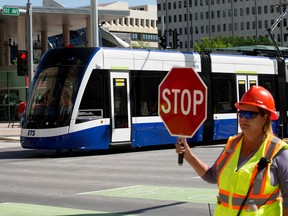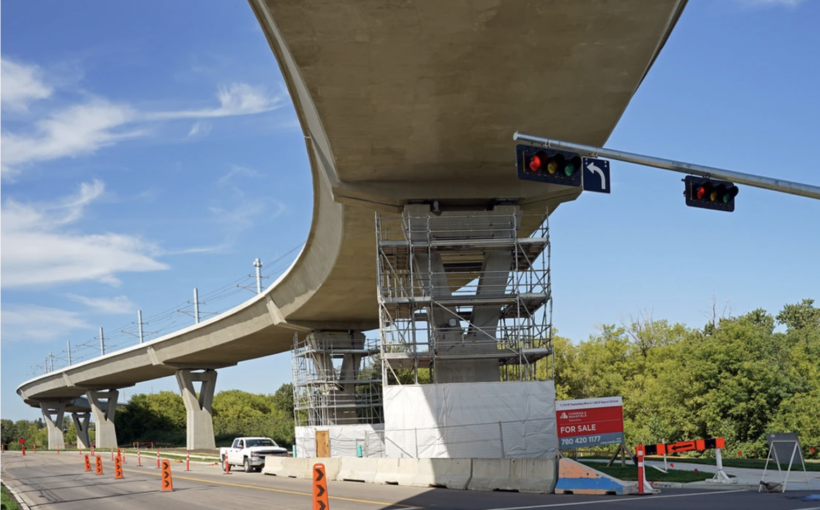A public inquiry was just completed this week on the LRT debacle in the nation’s capital, and it is entirely feasible that a similar process may need to be held in Alberta’s capital if our own fiasco keeps going the way it has.
For those unfamiliar with Ottawa’s situation, the $2.1-billion Confederation line has been a civic embarrassment, plagued by a 15-month construction delay followed by derailments, mechanical breakdowns and shutdowns.
“Egregious,” “unconscionable” and “deliberate malfeasance” were among the most colourful terms in an inquiry report so damning that it’s hard to imagine the defective monorail from The Simpsons faring worse.
To be clear, Ottawa’s problems are Ottawa’s problems, and we should be cautious about projecting their failures onto our own struggles with Edmonton’s southeast Valley Line.
The most obvious difference, of course, is that our $1.8-billion rail project isn’t exactly being rushed into service, given that it is already two years delayed and counting.
Despite obvious political and financial pressures, the city and TransEd — the consortium hired to design, build, operate and maintain the line under the P3 format — at least seem to have placed safety as a top priority.
That distinction noted, there are still a few things in the Ottawa inquiry report that may have some relevance to Edmonton. These include:
• Unproven technology in the low-floor LRT cars designed for Ottawa by Alstom (formerly Bombardier);
• An acrimonious relationship between Ottawa and its LRT contractors, which sets up the potential for a long-term “dysfunctional partnership” since those contractors are assigned to keep the rail line in good working order for 30 years;
• Inadequate maintenance provided by the contractors and subcontractors.
How might such findings hold lessons for Edmonton?
For one thing, the low-floor cars purchased for the Valley Line are also made by Alstom, and though they are not the same model used in Ottawa, they are still of a design that does not appear to have an extensive track record in cold North American climates just yet. That’s a potential risk, as is the fact that the Valley Line will eventually be using a second type of car, made by Hyundai Rotem.
In addition, Edmonton’s partners seem to be developing their own fractious relationship, given that civic leaders have become increasingly upset with TransEd’s performance. That frustration is warranted, but it also creates greater potential to be trapped in a dysfunctional transit marriage for the next three decades.
We may also want to take note of the findings from Ottawa on unrealistic timelines and the influence of financial pressures.
Right now the focus is on 30 cracked piers, and questions linger as to why such a mistake happened in a city where local concrete-rebar engineering requirements should be well understood.
Nonetheless, remember that this is only the latest setback. The first 18 months of delays were chalked up to the discovery of a large concrete block in the river and the impacts of COVID.

I have been skeptical that these factors alone could put construction a year-and-a-half behind schedule, which raises the possibility that the original timelines negotiated by TransEd and the city simply weren’t practical. It’s at least worth exploring the question.
Likewise, the longer the line is delayed, the greater the questions around financial difficulties.
The city appears to have done a good job on its contracts, which means taxpayers are not on the hook for additional costs. All of that falls on TransEd, which is also forgoing payments every month the line remains out of service.
Hopefully, such financial pressure won’t play out here the same way it did in Ottawa, and there will be no temptations to skimp on maintenance.
“TransEd partner companies are large and well positioned to manage the financial impacts from the pier repair and delay,” TransEd said in an emailed statement. “Safety and quality of the LRT line has always been and continues to be the highest priority and will not be compromised.”
Nonetheless, it’s hard not to wonder what the limits are, especially since the consortium recently received a credit downgrade.
Unfortunately, all we can do is wonder, which brings me to one last recommendation from Ottawa that calls for all levels of government to examine whether P3s are appropriate for public transit projects.
Some observers correctly note that delays and design flaws can happen to any project no matter the delivery model, and we have certainly seen plenty of examples of that in Edmonton.
As such, the P3 probably isn’t to blame for the Valley Line’s physical problems, and the model does offer an advantage in putting risk and debt onto the contractor’s ledgers instead of the city’s.
However, I see a serious drawback when it comes to transparency and accountability.
Under a typical publicly delivered project, city managers would be required to provide regular updates to council, and publicize various numbers, documents and audits, all with a certain level of trust.
Under the P3 model, most communications are controlled by TransEd, which, to me, has not been consistently transparent with important information about its progress. And because they are a private entity, many details of the project appear to be exempt from freedom of information access.
Edmontonians are rightly upset about delays that still have no stated endpoint, but it is additionally frustrating to feel there is limited recourse for answers or a direct line of accountability to elected officials.
The first order of business, obviously, is still to get the Valley Line up and running. But at some point, we also deserve a full accounting of the delays, which have produced harms both financial and reputational.
Much of that falls on TransEd, and P3s generally, but it goes beyond that.
People have moved or made life decisions based on expectations that they would have timely access to an LRT line.
Moreover, the city is in a real public relations battle right now on transit ridership and on convincing the public of the value of expensive mass transit infrastructure. Vital municipal goals around climate change and having a more sustainable city depend upon public confidence in transit. The voices for cancelling all future LRT lines and adding more roads are getting louder.
Hopefully, that confidence can be fully restored. But I suspect part of that process requires our own investigation akin to Ottawa’s, both to reveal what went wrong and to make sure it doesn’t happen again.
Source: EdmontonJournal




